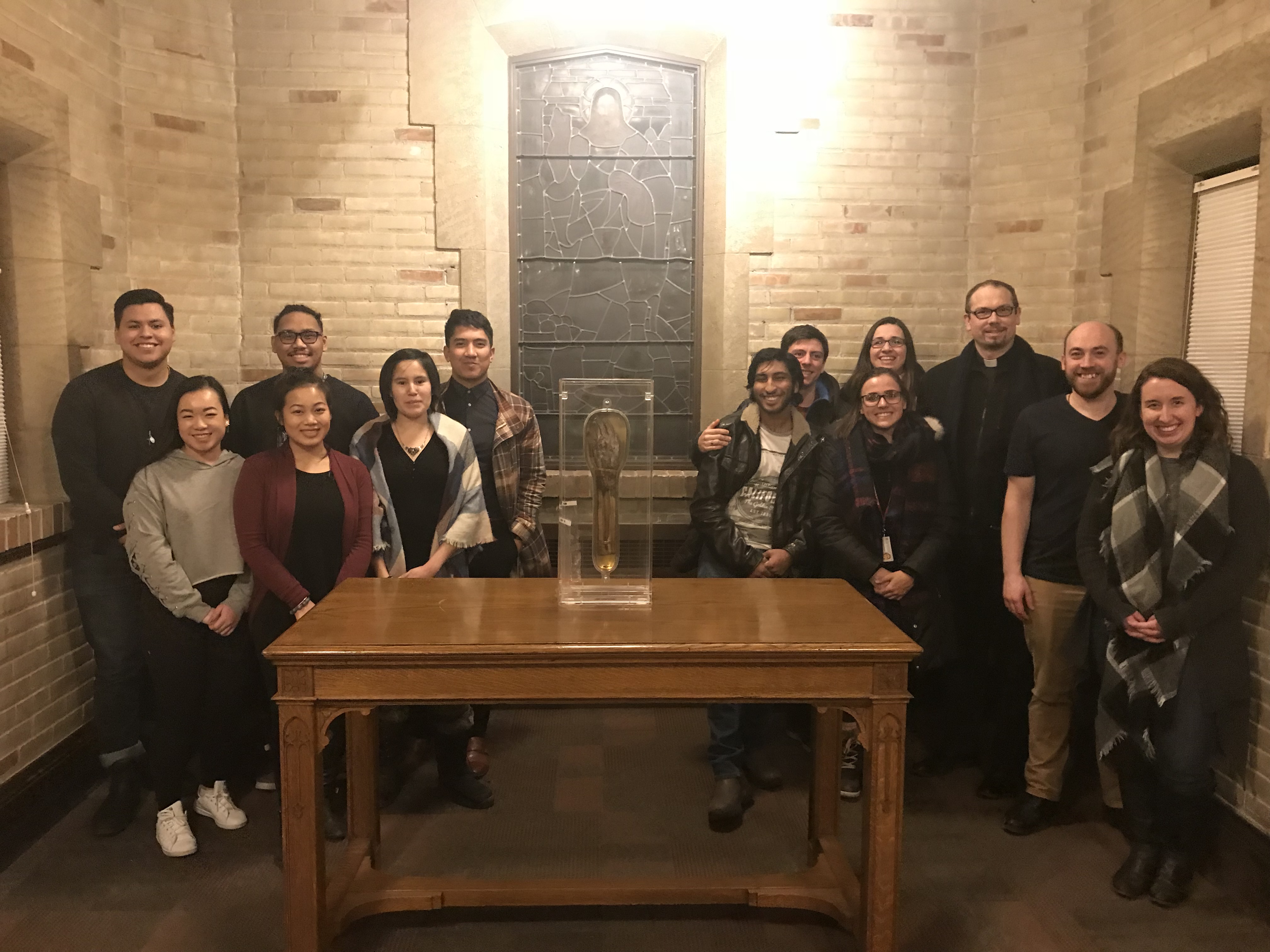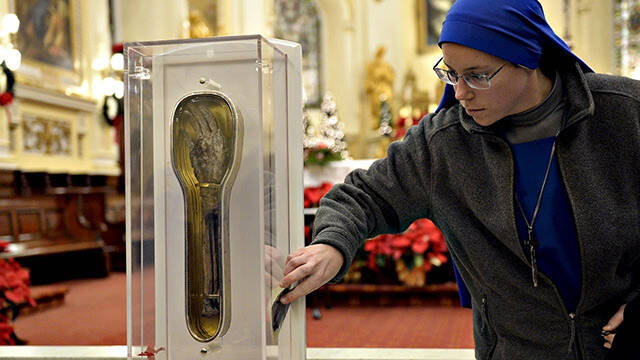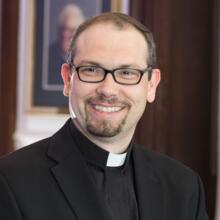I first encountered the arm in the lobby of a Holiday Inn in Winnipeg. Even hidden in its armored reliquary, behind a plexiglass box, wrapped in a rectangular canvas tote-case, the sense of the ancient and the sacred struck me viscerally. Without thinking, I began to pray.
The arm belonged to St. Francis Xavier, a companion of St. Ignatius Loyola who traveled thousands of miles as a missionary to the Far East. He was peerless in his ability to call people to Christ or to deepen existing faith. He baptized nearly 100,000 souls with that arm and blessed countless more.
When I was asked to accompany a 465-year-old arm across Canada, various fears and questions flashed across my mind. What are people going to think about us promoting relics in the 21st century? What if this turns out to be a public relations disaster for the Catholic Church in our very secular country? What will it be like going through airport security and onto planes (the arm had its own seat) with this human artifact? What exactly do I believe about such religious objects, and how can I articulate it in the interviews that would ensue?
When I was asked to accompany a 465-year-old arm across Canada, various fears and questions flashed across my mind.
But I also knew this was a rare opportunity to promote vocations, which is my current assignment as a Jesuit. A devotional tour in parishes and universities in all the major cities of our vast nation? You could not buy this kind of access to the people of God, and all under the auspices of Xavier, one of the most popular saints and the charismatic co-founder of the Society of Jesus.
The idea for the pilgrimage was conceived by the Jesuit Archbishop Terrence Prendergast of Ottawa and organized by the university movement Catholic Christian Outreach. I had been invited to be the Jesuit representative on this coast-to-coast tour. Within the 100,000 glossy booklets printed for the events, three intentions were proposed: conversion of hearts, personal healing and the raising up of new missionary disciples. The last aim fit my mandate quite neatly.

When I joined the tour mid-January in Winnipeg, it was 22 degrees below zero. The cold added to my jitters over an exotic enterprise, fraught with many unknowns. Yet from the start there were indications that something powerful was happening. Nearly a thousand young adults attended the conference where the relic debuted, showing remarkable reverence and emotion. The national broadcaster, CBC, covered it on their evening news show with surprisingly respectful, if slightly whimsical tones. Local organizers were advised to prepare for double or triple expected numbers, and in one Toronto parish, 14,000 Catholics of Goan descent came out to venerate the relic one afternoon.
Perhaps Xavier was working to reconnect us today, to God, to creation and to each other.
In cities across the country, large crowds brought their written prayer petitions and touched them to the glass for a few seconds, then deposited them in baskets that would later be distributed to contemplative communities across Canada. Security for the event in Winnipeg was provided by a group of Knights of Columbus motorcycle enthusiasts, complete with goatees and biker patches. One club member, who spent 12 hours ushering people to the relic, left at the end of the day with tears rolling down his cheeks. He told us it had been the most important day of his life. There were many others like him.
When I had my first of many media interviews, I tried to explain why Catholics were coming out to see a mummified arm. I told reporters that it is very Catholic to have a spiritual experience through tangible things, that our whole sacramental system is premised on an incarnational outlook. Since we believe “the Word became flesh,” it is not much of a stretch to believe that the material and the flesh can lead us back to the Word. I said that Catholics have deep instincts and long memories and that the saints evoke ancestral graces.
I was asked to give talks in the cities we visited, unpacking Xavier’s life and explaining the theological roots of our tradition of venerating relics. I learned it was a deeply scriptural practice, going back to the Old Testament when a dead man was mysteriously restored to life when he was laid on the bones of Elijah. The Jewish instinct for recognizing God at work in the material world is retained in the Gospels, as when Jesus spits onto his thumbs and rubs them on a blind man’s eyes, restoring his sight. It occurs when the woman with the hemorrhage knows she needs only to touch the hem of Jesus’ garment to be healed. The early church, too, would care for the bones of the beloved departed and observed special graces connected to their presence.
The instinct may be buried, but the pull of the sacred relics endures.
Healing is needed today in Canada between the indigenous and non-indigenous peoples. One day on the tour, I was hearing the confession of a woman who asked to pray the act of contrition in the Cree language. Moved by her request, I was reminded of St. Jean de Brébeuf and the other Jesuit missionaries of North America, who noted the great reverence the native people had for the bones of their dead. Most non-Western cultures, unafflicted by the Cartesian split between spirit and body (of which we are all heirs), seem to have a healthy instinct for the importance of the incarnational. Perhaps Xavier was working to reconnect us today, to God, to creation and to each other.
While we are a little light on saintly ossuaries in North America, Europe is covered with shrines and tombs that testify to the long-enduring Christian belief in the intercession of saints through the veneration of their earthly remains. Yet even in Canada, the bones of Brébeuf himself are visited by hundreds of thousands every year in Midland, Ontario. The instinct may be buried, but the pull of the sacred relics endures.
In his Spiritual Exercises, St. Ignatius encourages devotion to the saints, including their relics. This was not just a strategic move of the Counter-Reformation. After hearing countless confessions, conversations and testimonies on this tour, I now believe he was underlining a profound truth: that the saints will always be with us, spending their time in heaven quite active on earth. We activate their power by saying their names and spending time with them. It is part of the mystery of belonging to the great family of believers spanning earth and heaven, all laboring together for our collective good.
By the end of the tour, the country had been canvassed, the booklets were gone, the media coverage had been positive and respectful. Even many of the airline and security personnel wanted to touch the relic-case for themselves. Frankly, I was tired. But my heart was unusually full. Sometimes you scatter, and sometimes you reap. A tremendous labor of seeding had taken place, which I hope will see a bountiful harvest of conversions, healings and vocations. Mainly, however, I found my own faith had been set on fire, to follow in the footsteps of Francis Xavier and spread the Gospel far and wide.











Sorry. I feel today, in the Summer of 2018, as I did in the Summer of 1966 at St. Louis U. when I gazed on this arm: mystified that someone's arm was in a cask and people were going mystic over the thing. Appalling.
Comes down to this, the Communion of Saints “I now believe he was underlining a profound truth: that the saints will always be with us, spending their time in heaven quite active on earth.“
Relics do help us to pray. A fine article, John. Kudos to you and Archbishop Terry for realizing this project.
I have a very mixed reaction these days to such a public display of relics which are body parts. Intellectually I find it macabre and off-putting. Emotionally I still find it motivating and inspiring. I live with both sets of reactions and I am not sure how.
Here in NYC, a visit to the shrine of Saint Frances Xavier Cabrini, her body visible under the main altar, reminds us of her reality, a holiness lived in difficult times and circumstances, a holiness of advocacy for the poor, the sick, the immigrant. Perhaps because it is her entire body that I do not find it as macabre and off-putting as a part of the body of Saint Francis Xavier. Yet St. Francis Xavier is the great proselytizer of the East, an advocate for the common humanity of all persons in this world in Jesus Christ.
The author speaks correctly. For we Catholics, relics are the tangible and worldly documentation of the power of holiness and Christian belief.
Reading this article reminds me of a possible parallel in that display of actual human bodies spectacularly splayed and plasticized. It's defended as an educational experience teaching about the function of the human body and the physicality of humaness. I also have visited the Mütter Museum in Philadelphia with its display of mummified remains of diseased and deformed individuals, originally used for teaching purposes. So perhaps something can be learned from gazing upon the mummified arm of Saint Francis Xavier. One heck of an arm.
This is one of the reasons that I'm no longer a Roman Catholic. This is such utter nonsense and so utterly pagan in origin that it is utterly repugnant.
I wonder how an arm promotes an awareness of the life of St Francis Xavier. How does it foster an awareness of him and his presence and his actions. It appears that it creates an opportunity to discuss his life and his heroic acts. But do we need an arm to do that?
Perhaps we should use today's technology and create a hologram of the saint. This would not be flesh and blood, something that tells us that he was real but his arm is carbon. The danger of this sort of thing is that it potentially confuses the presence of Jesus in the Eucharist with the presence or reminder of a saint in a relic. People seem to have no issue with visiting a grave site of a loved one. Certainly this promotes some sort of linkage with the deceased. In some countries ashes of the deceased are venerated. I think in our culture an arm is just a bit to real a reminder of how destined we are to return to dust.
"The bodies of the dead must be treated with respect and charity" CCC 2300
I see no respect in this kind of exhibition.
People travel to Jerusalem to venerate a part of the remains of the Temple Wall, kissing it, touching it, praying before it and no one objects. This is as it should be, not because of its historical significance, but because at one time it was the dwelling place on earth of the Great "I Am" making it forever holy.
Our human bodies encompass our souls, made in the image and likeness of God, meaning that our bodies alive, or dead, are constantly caressing God, making them holy. Our bodies are Temples of the Blessed Trinity through Baptism, very venerable bodies, living, or deceased, as is the blessed arm of St. Francis Xavier.
I venerated that blessed arm in the Jesuit Church in NYC, where it ordinarily resides and it was a soaring experience! If you get a chance to venerate God in the remains of His blessed Saint, Francis Xavier, consider yourselves uniquely honored, blessed by the holy Jesuit priest Francis Xavier and in fact by the Great "I Am," One God in Trinity.
Thanks, Fr. O'Brien, for the article. I was a part of the relic tour through Canada and surprised at how grace-filled the whole event was. And how the young people responded so favorably to it! The way I see it, relics are the remains of saints that commemorate our God-given body. They celebrate material reality. To cast a shadow on relics is to disparage that which is most humble (earthly) about humanity. We visit relics because they remind us that saints are our friends, that their spirit lives with us, and that, by the grace of God, their lives endure alongside our own in a real and tangible way.